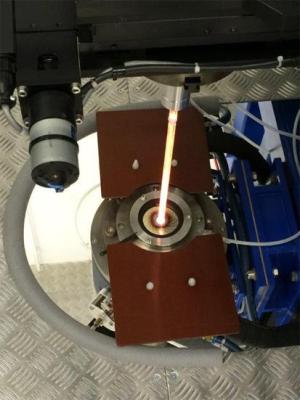Aug 6 2015
The ECOAL-MGT project, designed to minimize the environmental problems caused by coal waste piles beside forests, has successfully been completed following tests carried out in San Pedro da Cova (Portugal). This was the conclusion expressed by the lead researchers during the final workshop held at the end of June in the Portuguese locality of Gondomar.
 This image shows the manufacturing of special optical fibers at the XLIM Research Institute in Limoges (France). (CREDIT - (c) XLIM)
This image shows the manufacturing of special optical fibers at the XLIM Research Institute in Limoges (France). (CREDIT - (c) XLIM)
Prof Manuel López-Amo Sainz, the coordinator of the NUP/UPNA team of researchers, explained that an integrated system had been developed to measure the temperature and levels of contaminating gases caused by the piles of coal waste residues beside forests. "This waste matter resulting from mining activity can burn spontaneously, reach temperatures in excess of 300 ºC in its innermost layers and be continuously burning and spreading the combustion area to nearby forests and as well as causing health problems for the adjoining populations."
In this context, he pointed out that the combustion takes place in piles close to disused mines and which usually cover a very broad area. "What we have here is a worrying phenomenon that is seriously affecting several mining zones in a number of countries."
In the final phase of this project, started in 2012, an ongoing study was made of coal slag heaps. This monitoring allows the hazards and evolution of the scenarios to be identified so that action can be taken in time to minimize the negative impact of this waste material.
"ECOAL-MGT: Ecological Management of Coal Waste Piles in Combustion" is a project being co-funded by the European Union through its ERDF funds within the Territorial Cooperation Programme of the Southwest European Space- SUDOE (SOE/P2/P714). Researchers from various institutions in Portugal (University of Oporto and INESC), Spain (NUP/UPVA-Public University of Navarre and the University of Alcalá) and France (University of Limoges and the XLIM Research Institute) have participated in it. It was one of the 21 projects approved from among the 319 submitted within the 2012 call. The project had the advisory assistance of SODENA through its CEO Carlos Fernández Valdivielso, who was the Spanish expert proposed by the consortium.
Innovative sensors
The researchers of the NUP/UPNA-Public University of Navarre were Manuel López-Amo Sainz, Rosa Ana Pérez-Herrera, Ana Pinto, Aitor López-Aldaba, Silvia Díaz-Lucas, Alayn Loayssa-Lara and Sergio Rota-Rodrigo. They worked on the development of the multiplexing system of point sensors for gas (CH4, CO2 and NH3) and temperature and developed new temperature sensors using photonic crystal optical fibres capable of withstanding the high temperatures on the land that needed to be monitored.
The system was successfully fitted at San Pedro da Cova (Portugal) and was specifically designed using the latest technology in optical fibre point sensors (gases and temperature) and distributed sensors (temperature). This enabled a remote, multi-point measurement to be carried in the land that was the object of the study.
Measurements were obtained of the levels of toxic gases generated by the slag heaps and being endured by the neighbouring population. The temperature variation data inside the waste were analysed to detect the most likely directions of propagation of the zone in combustion.